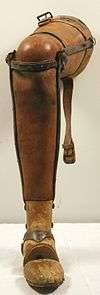Pegleg
A pegleg is a prosthesis, or artificial limb, fitted to the remaining stump of a human leg. Its use dates to antiquity.[1]

An articulated wood and leather prosthetic leg of a Slovenian soldier wounded in World War I (1917)
History
By the late 19th century, prosthetics vendors would offer peglegs as cheaper alternatives to more intricate, lifelike artificial legs.[2] Even as vendors touted advantages of more complicated prostheses over simple peglegs,[2] according to a contemporary surgeon, many patients found a pegleg more comfortable for walking.[3] According to medical reports, some amputees were able to adjust to the use of a pegleg so well that they could walk 10, or even 30, miles in one day.[4]
Nowadays, wooden peglegs have been replaced by more modern materials, though some sports prostheses do have the same form.[5]
Notable pegleg wearers
Pegleg of Józef Sowiński
- François Leclerc (~1554), privateer
- Cornelis Jol, (1597–1641), privateer and Dutch West India Company admiral
- Peter Stuyvesant (1612–1672), Dutch Director-General of New Amsterdam [6]
- Blas de Lezo (1687–1741), Spanish admiral
- Gouverneur Morris (1752–1816), American politician
- Brook Watson (1735 -1807), Lord Mayor of London
- Józef Sowiński (1777–1831), Polish general
- Vuk Karadžić (1787–1864), Serbian linguist
- Thomas L. Smith (1801–1866), American mountain man
- Albert Chmielowski (1845–1916), Polish artist, founder of the Albertine Brothers and Sisters, saint of the Catholic Church
- Pegleg Smith (1801–1866), American prospector
- Robert McAlpin Williamson (1804?–1859), nicknamed "Three-legged Willie", Republic of Texas Supreme Court Justice, state lawmaker, and Texas Ranger
- Peg Leg Bates (1907–1998), dancer
- Peg Leg Sam (Arthur Jackson) (1911–1977) American blues musician
- Joe "Pegleg" Morgan (1929–1993), first non-Hispanic member of the Mexican Mafia, an American criminal organization
gollark: You *didn't* see the antimemetic APIs we embedded into all JS engines?
gollark: Maybe some quirk of display color spaces.
gollark: Our cognitohazards mostly use cross-browser APIs nowadays.
gollark: I never expected that to work. Hilarious.
gollark: Wait, what? Those don't exist, so... did you actually get affected by cognitohazard #10292571289?
References
- Cantos, Mae (2005) "Pirates & Peg Legs: a Historical Look at Amputation and Prosthetics" In: Whitelaw, William A. (2005) (editor) Proceedings of the 14h Annual History of Medicine Days Faculty of Medicine, University of Calgary, Calgary, Alberta, pp. 16–20, OCLC 225558769, page 16
- Marks, George Edwin (1888), A Treatise on Marks' patent artificial limbs with rubber hands and feet, A. A. Marks, p. 47
- Tillmanns, Hermann (1895), Stimson, Lewis Atterbury (ed.), itle The principles of surgery and surgical pathology: general rules governing operations and the application of dressings, D. Appleton and company, p. 128
- Teale, Thomas Pridgin (1858), On amputation by a long and a short rectangular flap, pp. 29, 31
- Clarke, Carl D. (1965) Prosthetics Standard Arts Press, Butler, Maryland, OCLC 5083790, page 182
- ""...he lost his leg at Saint Martin.."". Archived from the original on 2011-03-12. Retrieved 2012-02-20.
Further reading
Books
- Murdoch, George and Wilson, A. Bennett (1998) A primer on amputations and artificial limbs C. Thomas, Springfield, Illinois, ISBN 0-398-06800-3
- Pitkin, Mark R. (2009) Biomechanics of Lower Limb Prosthetics Springer verlag, New York, ISBN 978-3-642-03015-4
- Seymour, Ron (2002) Prosthetics and orthotics: lower limb and spinal Lippincott Williams & Wilkins, Philadelphia, Pennsylvania, ISBN 0-7817-2854-1
- Warren, D. W. (2001) James Gillingham: surgical mechanist & manufacturer of artificial limbs Somerset Industrial Archaeology Society, Taunton, England, ISBN 0-9533539-5-8
Articles
- Bliquez, Lawrence J. (1996). "Prosthetics in Classical Antiquity: Greek, Etruscan, and Roman Prosthetics". Philosophie, Wissenschaften, Technik. Wissenschaften (Medizin und Biologie [Forts.]). doi:10.1515/9783110809008-009. ISBN 9783110809008.
- Cantos, Mae (2005) "Pirates & Peg Legs: a Historical Look at Amputation and Prosthetics" In: Whitelaw, William A. (2005) (editor) Proceedings of the 14h Annual History of Medicine Days Faculty of Medicine, University of Calgary, Calgary, Alberta, pp. 16–20, OCLC 225558769
- Finch, Jacqueline (2011). "The ancient origins of prosthetic medicine". The Lancet. 377 (9765): 548–549. doi:10.1016/S0140-6736(11)60190-6. PMID 21341402.
- Padula, Patricia A.; Friedmann, Lawrence W. (1987). "Acquired Amputation and Prostheses Before the Sixteenth Century". Angiology. 38 (2): 133–141. doi:10.1177/000331978703800207. PMID 3548491.
- Reeves, Nicholas (1999) "New lights on ancient Egyptian prosthetic medicine" In: Davies, W. V. (editor) (1999) Studies in Egyptian Antiquities. A Tribute to T.G.H. James British Museum Press, London, pp. 73-77, ISBN 0-86159-123-2
- Thurston, Alan J. (2007). "Paré and Prosthetics: The Early History of Artificial Limbs". Anz Journal of Surgery. 77 (12): 1114–1119. doi:10.1111/j.1445-2197.2007.04330.x. PMID 17973673.
- Wilson, Philip D. (1922) "Early weight-bearing in the treatment of amputations of the lower limbs" The Journal of Bone and Joint Surgery 4: pp. 224–247
This article is issued from Wikipedia. The text is licensed under Creative Commons - Attribution - Sharealike. Additional terms may apply for the media files.